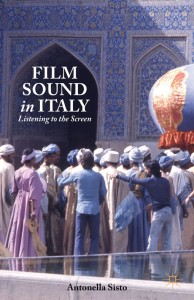Film Sound in Italy by Antonella Sisto (Palgrave Macmillan, 2014), 236 pages, ISBN: 978-1137387707 (hardback), £60
 About the reviewer: Professor Gordon has published widely on 20th-century Italian literature, cinema and cultural history. He is the author or editor of several books on the work of Primo Levi, including Primo Levi's Ordinary Virtues, Auschwitz Report and The Cambridge Companion to Primo Levi. He is co-editor of Culture, Censorship and the State in 20th-Century Italy and a study of cultural responses to the Holocaust in Italy. His work on cinema includes the books Pasolini, Forms of Subjectivity and Bicycle Thieves (BFI Classics series); DVD and blu-ray audio commentaries on Pasolini's Teorema and Bicycle Thieves; and articles and essays on Holocaust cinema, early film and literature, 'Hollywood on the Tiber', and censorship.
About the reviewer: Professor Gordon has published widely on 20th-century Italian literature, cinema and cultural history. He is the author or editor of several books on the work of Primo Levi, including Primo Levi's Ordinary Virtues, Auschwitz Report and The Cambridge Companion to Primo Levi. He is co-editor of Culture, Censorship and the State in 20th-Century Italy and a study of cultural responses to the Holocaust in Italy. His work on cinema includes the books Pasolini, Forms of Subjectivity and Bicycle Thieves (BFI Classics series); DVD and blu-ray audio commentaries on Pasolini's Teorema and Bicycle Thieves; and articles and essays on Holocaust cinema, early film and literature, 'Hollywood on the Tiber', and censorship.
Film is an ‘audiovisual medium’, but it has long been a truism to note that far more attention has been paid in film studies to the ‘visual’ part of that hybrid formula than to the ‘audio’ part. There are exceptions, especially in the area of film music, but the general truth still holds. Antonella Sisto’s rich new book is part of a small but important wave of work that vigorously contests this sensory one-sidedness, programmatically calling on us to ‘listen’ to the screen as much as we ‘watch’ it and to acknowledge the multifaceted, indeed transformative impact of the aural / oral on everything we think we know about the medium. Sisto teases out complementary facets of the different layers of film sound –music, voice, ambient noise – and shows how the uses of each are both narrowly historically determined by local production conditions and politics, and yet also at times open to subtle, even radically disquieting deployment. She shows how some of the most sophisticated and innovative of filmmakers were deaf to the effects of sound, even as they innovated visually; and how some of the most crude totalitarian ideologues intuited that the control of film sound was central to the control and coercion of film audiences.
Sisto’s case study is Italy, drawing on a range of diverse material stretching from the 1930s to the 1970s, and the book’s prime audience will be students of that single national cinema. But she makes a good case for the particularities of the Italian industry and its cultural history as illuminating of the whole set of general historical, political and theoretical issues swirling around the field of film sound
 The book’s coverage divides neatly, although with a certain asymmetry of method and engagement, into two historical periods: first, the Fascist dictatorship (1922-1943) and then postwar democratic Italy, which spawned two remarkable generations of filmmakers, the neorealists of the 1940s-50s and the auteur directors of the 1960s-70s, here represented especially by Michelangelo Antonioni and Pier Paolo Pasolini. The first three chapters focus on the Fascist period. Sisto notes an extremely important historical ‘coincidence’ in the Italian case: sound cinema was born just as Mussolini’s regime began investing in cinema as the ‘strongest weapon’ of a modern totalitarian state. Sisto argues forcefully that the regime’s swift imposition of compulsory dubbing of foreign films was not just an economic expediency – a boost to local technicians and voice actors that has remained a mainstay of the Italian industry to the present day – but also a deeply ideological act: dubbing meants controlling, domesticating, even eliminating the voice of the foreign, the other. It is, in Sisto’s account, the very epitome of Fascism. If this case is somewhat stridently overstated at times, the study of Fascist-era dubbing, the debates around it and rare dissenting voices (a young Antonioni, perhaps the true hero of this book, was one), is an extremely useful corrective to standard accounts.
The book’s coverage divides neatly, although with a certain asymmetry of method and engagement, into two historical periods: first, the Fascist dictatorship (1922-1943) and then postwar democratic Italy, which spawned two remarkable generations of filmmakers, the neorealists of the 1940s-50s and the auteur directors of the 1960s-70s, here represented especially by Michelangelo Antonioni and Pier Paolo Pasolini. The first three chapters focus on the Fascist period. Sisto notes an extremely important historical ‘coincidence’ in the Italian case: sound cinema was born just as Mussolini’s regime began investing in cinema as the ‘strongest weapon’ of a modern totalitarian state. Sisto argues forcefully that the regime’s swift imposition of compulsory dubbing of foreign films was not just an economic expediency – a boost to local technicians and voice actors that has remained a mainstay of the Italian industry to the present day – but also a deeply ideological act: dubbing meants controlling, domesticating, even eliminating the voice of the foreign, the other. It is, in Sisto’s account, the very epitome of Fascism. If this case is somewhat stridently overstated at times, the study of Fascist-era dubbing, the debates around it and rare dissenting voices (a young Antonioni, perhaps the true hero of this book, was one), is an extremely useful corrective to standard accounts.
Not only foreign films were dubbed, however. Home-grown films were also or ‘post-synchronized’, creating a bland disconnect to the visual reality on screen, flattening any sense of place and local voice, and this continued well after Fascism. In chapter 4, Sisto is particularly trenchant with the postwar neorealists (brief, honourable exception is made for Visconti’s 1948 film, La terra trema), who somehow ignored the inauthenticity of their post-synce soundtracks, whilst simultaneously hymning the raw reality of their images. The aural failings of the neorealists leaves the field open for the final two chapters, on Antonioni and Pasolini, less film history and more built around close viewings and listenings of films such as Red Desert (1964) and Arabian Nights (1974). Neither directors abandoned post-synchronization; on the contrary, Sisto suggests they redeemed it from its Fascist roots, deploying panoplies of music, noise and voice to complicate and question, to probe and challenge subjectivities and sexualities and tap into the deepest mind-sense connections, in ways both primal and intellectually engaged. If we listen carefully to films such as these, Sisto suggests, film sound gets us to the very heart of the modern.
Robert S. C. Gordon